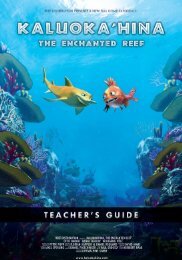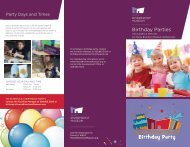EARTH, MOON & SUN - Peoria Riverfront Museum
EARTH, MOON & SUN - Peoria Riverfront Museum
EARTH, MOON & SUN - Peoria Riverfront Museum
You also want an ePaper? Increase the reach of your titles
YUMPU automatically turns print PDFs into web optimized ePapers that Google loves.
<strong>EARTH</strong>, <strong>MOON</strong> & <strong>SUN</strong>Sunteringthe stars instead of placing them carefullyin the sky as he is supposed to. Like anyinteresting character in a story, Coyote givesreaders and listeners much to consider, as theythink about his actions and motivations and tryto learn from them.Another story told in Earth, Moon & Sun involvesCoyote, Crow, and Moon. Coyote andCrow steal the Moon so they will have lightwhen they hunt at night. But when Coyotesneaks a look in the box where they’re keepingMoon, Moon escapes. And now, Moon hideswhenever Coyote is near. This story illustratesour perceptions of the Moon’s phases, whilealso providing another example of Coyote’sbetween this story and “Coyote and Crow.”1. Read aloud. Especially if you have veryyoung students, you may choose to read “Coyoteand Crow” aloud to the class, with your studentsfollowing along (with paper copies of thestory, or with a copy written or projected on theboard) so they know how to pronounce all thewords. You can also assign parts to students toread aloud: a narrator, Coyote, Crow. And youcan even ask students to act out the tale withsome of the same paper-bag puppets that havestarring roles in their food-chain skits (see p. 11for instructions).2. Investigate sounds. Ask your students tounderline or point out words in this tale thatbegin with a hard sound: cactus, carefully,caw, could, Coyote, Crowwords that end with the similar hard sound of: ask, back, look, pick, rock, walk. Stu-the word with a soft sound in it: nice (in“A nice bluebird,” on the ninth line).3. Discuss characters. Sometimes stories includecharacters who do not do the right thing.Is Coyote a character like that? Can your studentsremember mistakes that Coyote made inEarth, Moon & Sun? Were the mistakes intentionalor unintentional? What does Coyote doin “Coyote and Crow”? What mistake does hemake? What happens because of his action?What should Coyote have done? Coyote isnot the only character in “Coyote and Crow.”What about Crow? Is Crow a good character?What do your students think about the trick thatCrow played on Coyote? Was that a nice trickto play? What should Crow have done?4. Talk about fables. Typically, fables areshort, tell a story, and teach a lesson, and animalsare their main characters. Ask your studentswhether “Coyote and Crow” has any ofthe characteristics of fables. Are your studentsfamiliar with any other fables, like “The Tortoiseand the Hare”? You may wish to showbooks from the media center and read some selections,letting students know that fables havebeen told by people around the world for centuries.5. Explore settings. Though fables have beentold by many kinds of people around the world,origins. Ask your students what clues tell themthat “Coyote and Crow” comes from a particularpart of the United States? What about theanimal and plant life this fable refers to? Thediscussion of setting/environment can form aconnection to science content and an activitylike “Coyote and Sun” (see pp. 10-11 for instructions).6. Tell tales. Worksheets on the following pagesprovide frameworks for students to writetheir own fables or other types of stories aboutCoyote and Crow (or about Coyote and anotheranimal they choose). Ideas for characters andsettings can be drawn from the work studentsdo for “Coyote and Sun” if that activity is as- PLANETS, Morehead Planetarium and Science Center, University of North Carolina at Chapel Hill, NC 27599© 2010, 2011 by Morehead Planetarium and Science Center 6





